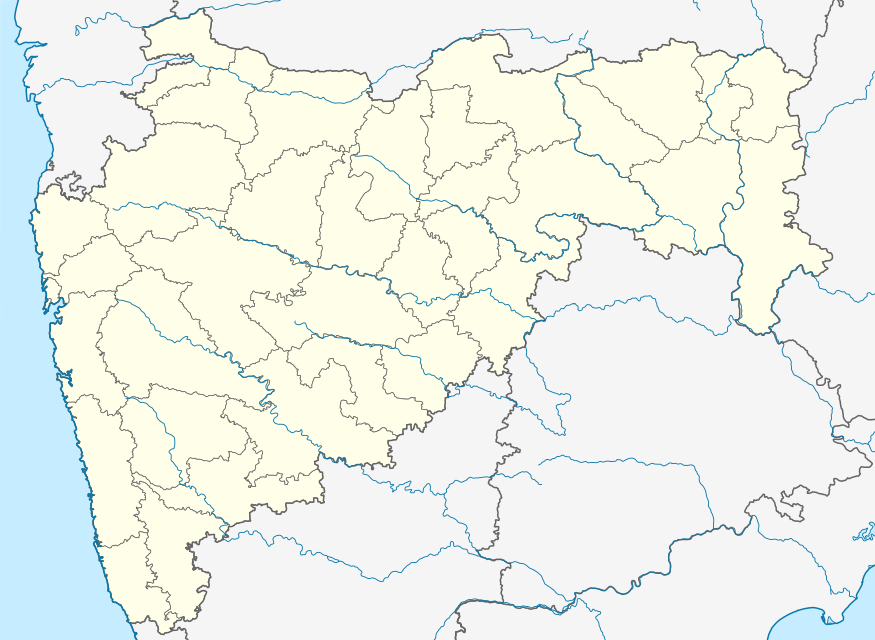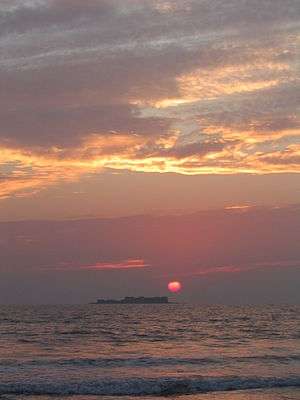Murud, Raigad
Murud is a City and a municipal council in Raigad district in the Indian state of Maharashtra. Situated at a distance of 150 km (93 mi) from Mumbai, Murud is a tourist destination. The Palace of Nawab is located in Murud. The palace was built in 1885 for administration purposes. The palace is still owned by the descendants of the Nawab and is a private property.
Murud Murud-Janjira ,MJ | |
|---|---|
City | |
 Murud Location in Maharashtra, India | |
| Coordinates: 18.33°N 72.96°E | |
| Country | |
| State | Maharashtra |
| District | Raigad |
| Government | |
| • Type | Municipal Council |
| • Body | Murud Municipal Council |
| • Mayor | Sneha Patil (Shivsena) |
| Elevation | 7 m (23 ft) |
| Population (2001) | |
| • Total | 12,551 |
| Languages | |
| • Official | Marathi |
| Time zone | UTC+5:30 (IST) |
| Telephone code | 021 |
| Website | http://www.murudjanjira.com/ |
About
Murud is known for a notable beach, and for its proximity to Janjira off the coast of Rajapuri, a sea fort. Murud-Janjira is the local name for a fort situated at the coastal City of Murud, in the Raigad district of Maharashtra, India. It is notable for being the only fort along India's western coast that remained undefeated despite Dutch and English East India Company attacks.
History
Main Land to Murud Janjira.At the time they seized the fort, the Siddis were employed by the Bahamani Sultan of Ahmednagar and a Habshi, Malik Ambar (1550–1626), held a prominent position in that government. Before the rise of the Maratha sardars, the courts of the Bahamani sultanates were rent by rivalry between the Indian Muslims and the foreign Muslims, as a result of which, the Sultans began to patronize the Marathas as a third force, leading to the rise of Shivaji and the Maratha Empire. Malik Amber initially rose to great prominence as the Prime Minister of Ahmednagar. He is credited with having carried out a systematic revenue settlement of major portions of the Deccan, which formed the basis for many subsequent settlements. When the Ahmadnagar kingdom was conquered by Bijapur and the Mughals in alliance, the Siddis switched their allegiance to the Sultanate of Bijapur; when the Bijapur kingdom was conquered by the Mughal Empire, the Habshis switched their allegiance to the Mughal Empire. As clients of these Muslim states, the Siddis were nominally part of their navies, and fulfilled the role of defending Muslim interests in the sea, and particularly, access by sea for the Hajj and Umrah, for which reason, the interior Muslim states felt compelled to aid and rescue the Siddis from their enemies. Despite being feudatories, first of Bijapur and then of the Mughals, the Siddis acted as if they were independent, and lived mainly by piracy on coastal shipping. The piracy of the Siddis provoked the various local powers to attempt to suppress them, but despite efforts by the Portuguese, Dutch, English and the Marathas, the fort was never conquered. The fort thus earned a reputation for being impregnable. The reputation may be false. Mass mobilizations by the English and Marathas were always forced off before they could complete the task by the intervention of another power, such as the Mughals, creating a diversion in order to prevent the fall of Murud-Janjira. The same happened with Goa, with the Mughals invading Maratha lands in order to divert Maratha attempts to conquer Goa. As the Muslim powers of the interior waned in the face of rising English power, the Siddi state submitted to England under the system of Subsidiary Alliance, becoming a dependency under paramountcy of the Kings of England. HH Nawab Sidi Muhammed Khan II Sidi Ahmad Khan was the last Ruler of Murud-Janjira. A patron of arts and culture, he supported such musicians as Beenkar Abid Hussain Khan. The state continued in this condition until late 1947, when the last prince acceded his state to the Indian Union, and his state was merged into the Bombay Presidency which was later transformed into the State of Bombay and the State of Maharashtra.
Geography
Murud is located at 18.33°N 72.96°E.[1] It has an average elevation of 7 metres (26 feet).
Demographics
As of 2001 India census,[2] Murud had a population of 12,551. Males constitute 48% of the population and females 52%. In Murud, 11% of the population is under 6 years of age.
Local food productions
Seafood: prawns, surumai, pomfret, kingfish, mackerel, crab, lobster. Vegetables: eggplant (brinjal), sweet potato, sugarcane, onions, garlic. Cereals: rice. Fruits: coconut, mango, watermelon, bananas, jack fruit, kokum. Nuts: Betel nut, cashew nut. Spices: black pepper. Fish surmai, rawas prons lobster octopus bombay duck(bombil)
Places of interest
- Murud-Janjira Fort (5 km south)
- Kasa Fort (Padmadurg)
- Korlai fort (30 km north)
- Khokari Tombs (5 km south)
- Victoria Water Works,Garambi (8 km)
- Phansad wildlife sanctuary (20 km north)
- Kude Buddhist caves (28 km south east)
- Sawat Kada waterfalls (7 km)
- Datta Mandir temple (1.5 km)
- Eidgah open mosque (1.5 km north)
- Sir Sidi Ahmed Khan Palace (1.5 km north)
- Siddhi Vinayak Temple (9 km north)
- Birla mandir Temple (33 km north east)
- kashid beach (21 km north east)
- Khar Amboli Dam (5 km)
Education
Below are the famous schools in Murud City
- Omkar Vidya Mandir
- Sir.S.A.Highschool and M.L.D.College
- Anjuman Islam Highschool and Degree College
- Vasantrao Naik College Of Arts & Commerce
- Nachiketas Public School
- Suvidya Public School
- Pioneer Public School
- Mehboob English medium School
Hospitals
- Murud Rural Hospital(F.B.Hospital)
- L.K.B.Hospital
- Kalyani Hospital
- Muqbool Narsing Home and Hospital
- Shree Clinic
Port
- Agardanda Terminal (5 km south)
- Dighi Port (5 km south)

References
- Falling Rain Genomics, Inc - Murud
- "Census of India 2001: Data from the 2001 Census, including cities, villages and towns (Provisional)". Census Commission of India. Archived from the original on 16 June 2004. Retrieved 1 November 2008.